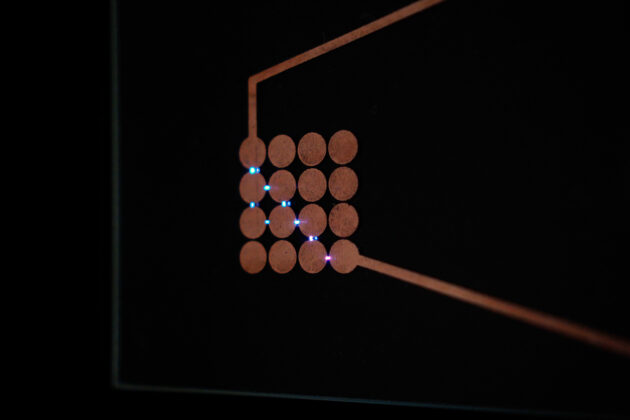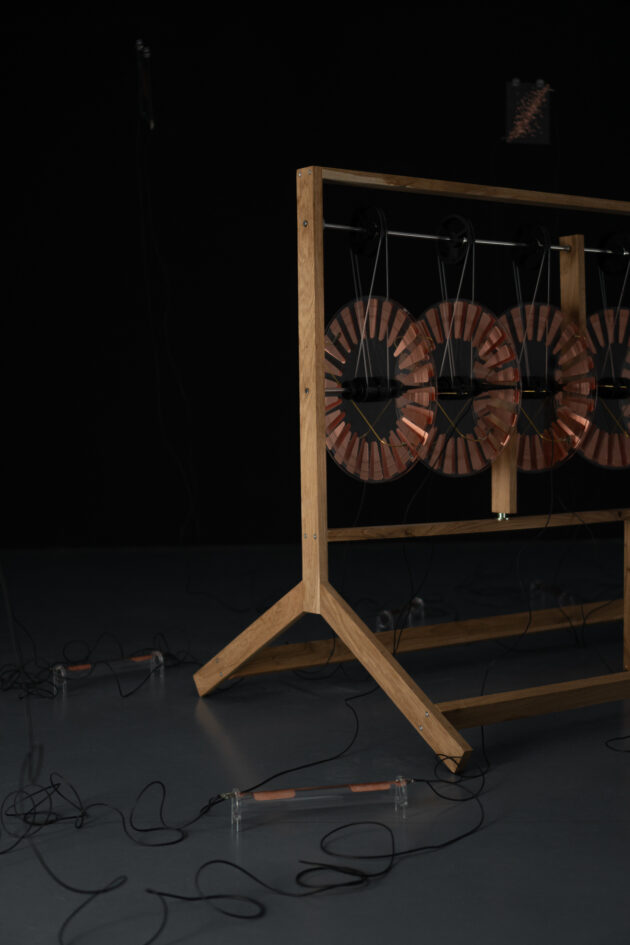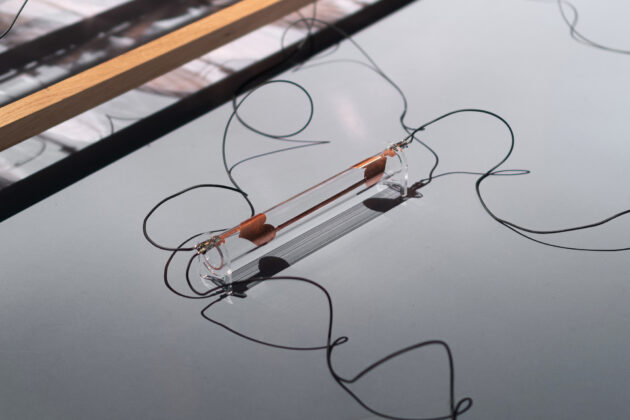Towards an Intimate Electricity
Towards an Intimate Electricity is an artistic research into histories, poetics and intimacies of electricity. It raises questions about how we relate to electricity and – by electric means – to others. The installation enacts an intimate electric imaginary in which currents of intimacy flow alongside and around electricity beyond notions of mere fuel.
This work begins with a digital media artist realizing that she is actually an electric artist. As a media artist, electricity is the foundation of my artistic practice. The doing and thinking of my artistic practice happens largely electrically. Its possibilities and limitations impose a scope of possibilities and limitations on my own work as well. Less in a sense of a limited available amount of electric power measured in Watt, but much more fundamentally in a limiting notion of electricity, that tries to determine it primarily as fuel. This personal self-observation of my own practice aligns with an observation of the environmentalist scholar Alan Ackerman about modern culture in general. He argues electricity to be the generator of modernity in the first place. This work investigates and critiques this position of „electricity as source and limit of culture“ [1] and aims to rethink the relationship of electricity and culture, towards cultivating an alternative and expanded electric imaginary.


Installation
As an electric art installation, Towards an Intimate Electricity is deliberately not connected to the electric grid. Instead, it is built around the idea of placing energy producer and energy consumer in the same space, resulting in a setting that highlights their relation. It aims to create intimate experiences with the electric phenomena, as well as intimate insights that result from this proximity of producer, consumer and electricity.
The installation consists of an 8-channel electrostatic generator, a Leyden jar capacitor for each channel, as well as eight glass circuit boards. Turning the handle drives the electrostatic generators. Each channel acts as its own influence machine and generates charges up to 35kV. The generated charge is stored in the Leyden jar capacitors and accumulates. When the charge reaches the breakdown voltage of the air, it discharges as sparks on the glass circuit boards.
The circuit boards are made from copper etched on glass. They tell stories about (historical) poetic and intimate electrical moments – or rather speak of the presence or absence of intimacy in these moments. Some of the stories revolve around in/determinate grids, others speak of embedded and embodied electrical engagements, such as the electric kiss. [2] Another displays the poem (an end to) a means to an end that attempts to give brief impressions into conclusions of the research process.



Intimate Electricity
Intimacy embeds and embodies in various ways in this work, besides a spatial intimacy that can be noticed from the local proximity of energy producer and consumer. For me as the artist, while developing ways of safely engaging with high voltages, those initial dangers became intimate moments and experiences over time: My way of “measuring” the intensity of the static discharge was to just feel the sparks and intentionally touch it to get a feeling for how painful (or pleasant) it might feel. This turned out to be an intimate process of estimating and negotiating the contingent pain and risk on the one hand, and the desired brightness and loudness of the sparks on the other hand. Another form of intimacy might be felt in the way the electric sparks are acting and telling electric stories in a kind of autobiographical manner. Here, the artist is engaged more in the role of a curator of that electric history rather than its composer.
One more form of intimacy that can be noticed appears in how the sparks find their pathways: Where one might assume the sparks would discharge in straight and linear lines, choosing a most direct path of the least resistance through the air, we can observe that instead, the sparks exhibit a rich and dense indeterminacy of options. This displays as a playful trying out, drawing close, back-and-forth, and sometimes in taking various ways at the same time. In lightning, Karen Barad describes a similar in/determinacy: “These gestures are material imaginings, electrical flirtations signaling connections-to-come.” [3]


(an end to) a means to an end
i am resisting to be
nothing but your dream
i am material touch,
unsuspected kiss,
children of the sun,
multiple bright endings
of modern daydreams
i am power,
metaphor for an unending giving,
colonizer and accumulator,
material networks of control,
barbed wire on electric fencing
i am myth,
a secret fire,
the death in your eye,
a gentle bite on your finger
contracting your muscles
i am desire,
what drives your machine yearning,
physically attractive fields,
indeterminate grids,
an unlearned monstrous love,
i am bzzzzz,
the potential of a flow,
never static, never unidirectional,
continuous pulse,
dressed in alternating fields of electromagnetic radiation
i am un-universalized,
kiss me electric
at the dusk of modernity,
or (maybe rather) the dawn of its overcoming
i can become everything you dream of




(Installation view at Galerie Kramer, Bremen)
Materials
Oak wood, copper foil, glass, acrylic glass, brass tube, 3D-printed mechanical parts (PLA), PU driving belts, mechanical parts made from stainless steel, cables
References / Resources
[1] Ackerman, Alan (2017) Electricity
In: Szeman, I; Wenzel, J; Yaeger, P. (Ed.),
Fueling Culture. 101 Words for Energy and Environment
Published by Fordham University Press
[2] Die Electricität nach ihrer Entdeckung und Fortgang
Bose, Georg Matthias (1744), Wittenberg
[3] Barad, Karen (2021) TransMaterialities: Trans*/Matter/Realities and Queer Political Imaginings
In: Jaque, A., Verzier M. O., Pietroiusti, L. (Ed.), More-than-Human
Published by Het Nieuwe Instituut
Networks of Power. Electrification in Western Society, 1880-1930
by Hughes, Thomas P. (1983)
Colonialism and the Development of Electricity: The Case of Madras Presidency, 1900−47
by Rao, Srinivasa; Lourdusamy, John (2010)

